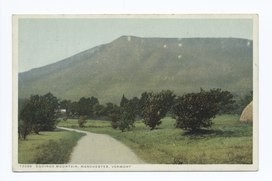| Taconic Mountains | |
|---|---|
 Mount Equinox (3,840 ft) in Vermont is the high point of the Taconic range | |
| Highest point | |
| Peak | Equinox Mountain, Bennington County, Vermont |
| Elevation | 3,850 ft (1,170 m) |
| Geography | |
| Country | United States |
| State(s) | New York, Connecticut, Massachusetts, Vermont |
| Region(s) | western New England, eastern New York |
| Range coordinates | 42°41.5′N 73°17.1′W / 42.6917°N 73.2850°W |
| Parent range | Appalachian Mountains |
| Biome | Northern hardwood forest, |
| Geology | |
| Orogeny | Taconic Orogeny |
| Rock age | 440 million years |
| Rock type | Thrust fault |
The Taconic Mountains (/təˈkɒnɪk/) are a 150-mile-long sub-range of the Appalachian Mountains lying on the eastern border of New York State and adjacent New England. The range, which played a role in the history of geological science, is separated from the Berkshires and Green Mountains to the east by a series of valleys, principally those of the Housatonic River, Battenkill River and Otter Creek. The Taconics' highest point is Mount Equinox in Vermont at 3,840 feet (1,170 m); among many other summits are Dorset Mountain, Mount Greylock and Mount Everett.[1][2][3]
Forests are predominately maple-beech-birch with some spruce-fir at higher elevations, "and oak and hickory common to the south and at lower elevations."[4] Parts of the Taconics are in the New England-Acadian forests ecoregion.[5] Although mostly private property, the Taconics contain a half-dozen sizable state forests and parks, as well as many preserves of lesser acreage protected by land trusts.[6][7][8][9][10] Several hundred miles of trails are within these mountains, including parts of the Appalachian Trail.
- ^ Day Hiker's Guide to Vermont 5th ed. (2006). Green Mountain Club: Waterbury Center, Vermont
- ^ Raymo, Chet and Raymo, Maureen E. (1989). Written in Stone: A Geologic History of the Northeastern United States. Chester, Connecticut: Globe Pequot.
- ^ Doll, Charles G. Centennial Geologic Map of Vermont (1961). United States Geological Survey: Washington
- ^ Griffith, G.E., Omernik, J.M., Bryce, S.A., Royte, J., Hoar, W.D., Homer, J., Keirstead, D., Metzler, K.J., and Hellyer, G., 2009, Ecoregions of New England (color poster with map, descriptive text, summary tables, and photographs): Reston, Virginia, U.S. Geological Survey (map scale 1:1,325,000)
- ^ Olson, David M.; Dinerstein, Eric; et al. (2001). "Terrestrial Ecoregions of the World: A New Map of Life on Earth". BioScience. 51 (11): 933–938. doi:10.1641/0006-3568(2001)051[0933:TEOTWA]2.0.CO;2.
- ^ "Taconic Crest Project" Rensselaer Land Trust. Retrieved February 13, 2011. "Taconic Crest Project". Archived from the original on 2015-05-25. Retrieved 2015-05-25.
- ^ [1] "Equinox Highlands, Manchester and Dorset, Vermont." The Nature Conservancy. Retrieved February 13, 2011.
- ^ Wildlands and Woodlands: A Vision for the New England Landscape. Harvard Forest (2010). Harvard University.
- ^ Cite error: The named reference
BNRCwas invoked but never defined (see the help page). - ^ "The Nature Conservancy and Intel Corporation Launch Berkshire Taconic Landscape Educational Web Site; New Educational Site for Parents, Students & Teachers Includes Educational Lesson Plans." (2002) PR Newswire Association, duplicated by thefreelibrary.com. Retrieved February 13, 2011. LLC [2]
